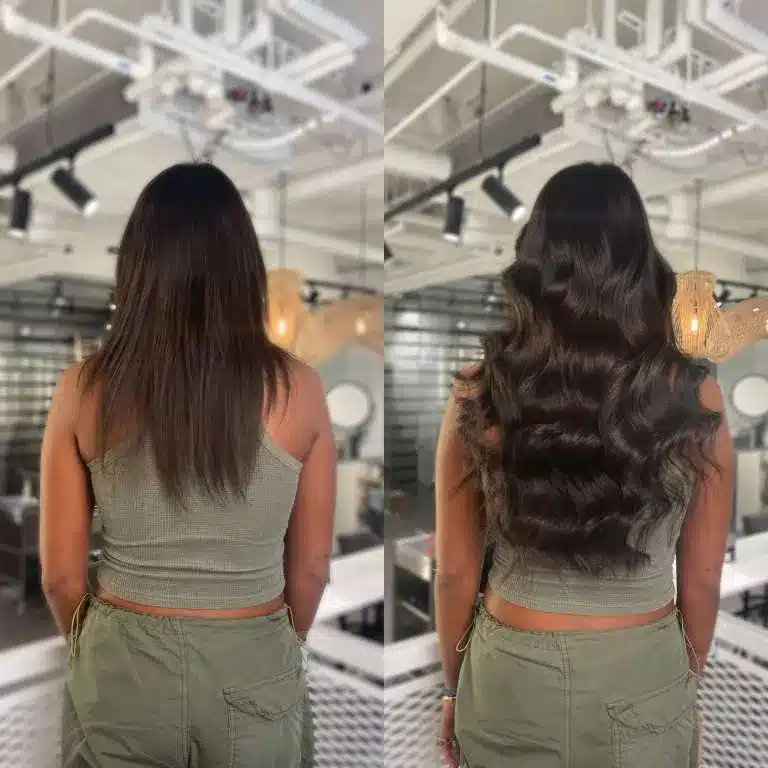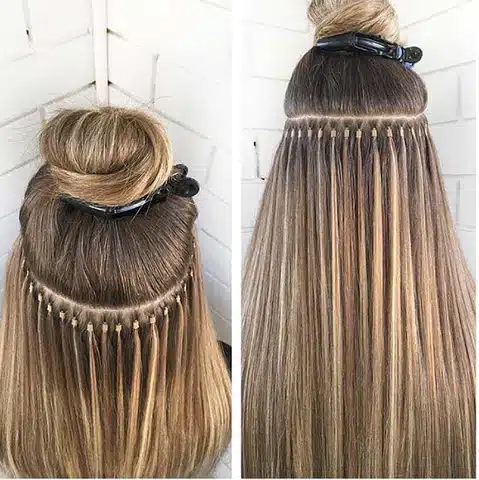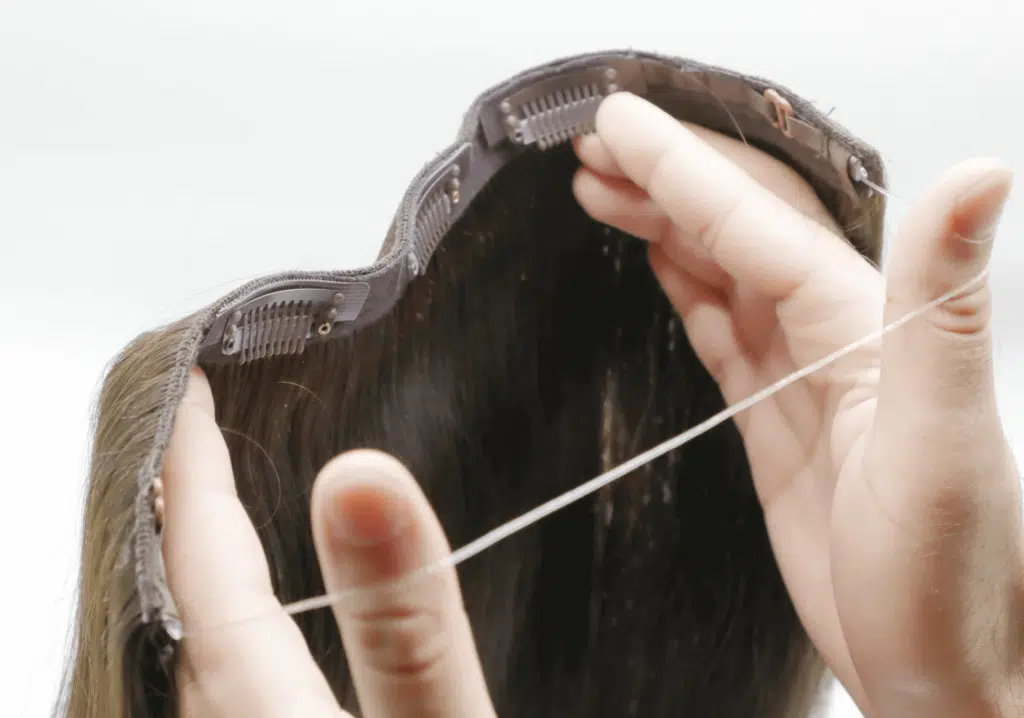As a professional stylist or salon owner, you’ve likely encountered clients with fine or thin hair, wondering what type of extensions will give them volume without weighing down their natural strands. Well, the good news is that there are plenty of options that can do just that! Let’s dive into which hair extensions are best for thin hair, so you can help your clients achieve the fuller, thicker look they desire—without compromising hair health.
Quick Answer: What Hair Extensions Are Best for Thin Hair?
For thin hair, the best types of extensions are tape-ins, microbeads, and halo extensions. These options are lightweight, discreet, and gentle on natural hair. They add volume and length without causing unnecessary stress or damage to the strands. In other words, they deliver the fullness your clients are after—without weighing their hair down.

What Type of Hair Extensions Are Best for Thin Hair?
When choosing extensions for clients with thin hair, it’s important to select lightweight options that blend seamlessly and don’t add bulk. Here’s a breakdown of the most suitable types of extensions for thin hair:
1. Tape-In Hair Extensions
Tape-in extensions are one of the best options for clients with fine or thin hair. They are flat, lightweight, and applied with a special adhesive tape. The tape is designed to sit flat against the scalp, making it almost invisible to anyone looking closely. This makes them a great choice for adding both volume and length while keeping things natural.
TAPE IN HAIR
Why Tape-Ins Are Ideal for Thin Hair:
Flat Design: The flat, tape application ensures they are discreet and comfortable to wear.
Seamless Blend: They provide a seamless integration with natural hair, blending beautifully.
No Weight: Tape-ins don’t weigh down the natural strands, which is crucial for fine hair.
Easy Maintenance: Tape-ins typically last 6 to 8 weeks with proper care, after which they can be reapplied.
Versatility: They can be styled, curled, or straightened just like natural hair, allowing for more styling options.
Tips for Using Tape-Ins on Thin Hair:
Use smaller sections of hair for a more natural look.
Ensure the tape is applied close enough to the roots to prevent any lifting or visibility.
Avoid overloading the hair with too many tape-ins. Less is more when working with fine hair.

2. Microbeads (Bead-Ups) Extensions
Microbead extensions are another excellent choice for thin hair. These extensions are attached by tiny, silicone-lined beads that grip natural strands without the need for glue or heat. Microbeads are lightweight and comfortable, ensuring they won’t weigh down fine hair.
KERATIN HAIR
Why Microbeads Work for Thin Hair:
Lightweight: The beads are small, ensuring the extension does not add weight to fine hair.
No Heat or Glue: These extensions are applied without any heat or glue, which is gentler on thin hair.
Discrete and Natural: The beads are small and blend well with the hair, offering a natural, seamless look.
Longevity: Microbeads can last 3 to 4 months with proper care and maintenance.
Tips for Using Microbeads on Thin Hair:
Make sure to distribute the beads evenly to avoid clumps of hair.
Take care not to pull too tightly when applying to avoid causing tension or damage to fine strands.
Regularly check for bead slippage or hair breakage and adjust as needed.

3. Halo Hair Extensions
Halo extensions are a non-permanent solution for clients who want an easy way to add volume and length. They come with a clear wire that sits comfortably on top of the head, securing the extension in place. Since there are no clips or adhesive involved, this is an excellent choice for clients with very thin or fragile hair.
Halo Hair Extensions
Why Halo Extensions Are Great for Thin Hair:
Non-Permanent: The clear, adjustable wire makes halo extensions easy to apply and remove, offering a quick solution without long-term commitment.
No Strain: Since the extensions sit above the natural hair, there’s no weight or strain added to the natural strands.
Comfortable: They sit comfortably without causing any tension or discomfort on the scalp.
Volume and Length: Halo extensions instantly add volume and length without any permanent changes to the natural hair.

Tips for Using Halo Extensions on Thin Hair:
Choose halo extensions made with high-quality, lightweight hair to ensure they blend naturally.
Adjust the wire to fit securely but comfortably, ensuring it doesn’t sit too tightly against the scalp.
Use halo extensions for events or special occasions where clients want temporary volume without the commitment.
Tips for Applying Extensions to Thin Hair:
When working with thin hair, it’s crucial to be strategic in your approach to ensure the extensions blend seamlessly and don’t damage the natural strands. Here are a few tips:
Use small wefts or individual strands: Smaller pieces of extensions will blend better with fine hair and won’t create excess bulk.
Avoid overloading with too many extensions: Thin hair doesn’t require a full head of extensions to create a fuller look. Stick to a few strategically placed extensions for the best results.
Consider a mix of methods: For some clients, combining tape-ins for volume and microbeads for length is a great way to achieve a natural, layered look.
FAQ: What Hair Extensions Are Best for Thin Hair?
Q: Can you get extensions with really thin hair? A: Yes, you can! Thin hair can still hold extensions if applied correctly. Lightweight methods like tape-ins, microbeads, and halo extensions are ideal for clients with very fine hair. Just be sure to avoid heavy methods, as they could stress the hair and cause damage.
Q: Do extensions damage thin hair? A: Extensions themselves are not inherently damaging to thin hair, but improper application or maintenance can cause damage. It’s important to choose lightweight options and follow proper care instructions to ensure the hair remains healthy.
Q: How long do tape-ins last on thin hair? A: Tape-ins typically last 6 to 8 weeks before needing a touch-up or reapplication. For thin hair, it’s essential to have regular maintenance to keep them looking fresh and prevent any slippage.
Q: How do I maintain hair extensions for thin hair? A: To maintain extensions for thin hair, ensure you’re using gentle, sulfate-free shampoos and conditioners. Avoid heavy styling products that can weigh down the hair. Regular brushing with a loop brush can prevent tangling and damage to both natural and extension strands.

Conclusion: Best Hair Extensions for Thin Hair
For clients with thin hair, tape-in extensions, microbeads, and halo extensions are some of the best options to create fuller, thicker hair without compromising the natural texture. Choosing the right extensions and applying them with care is key to achieving natural, long-lasting results. With these lightweight, gentle options, your clients can enjoy voluminous hair while maintaining the health of their natural strands.





